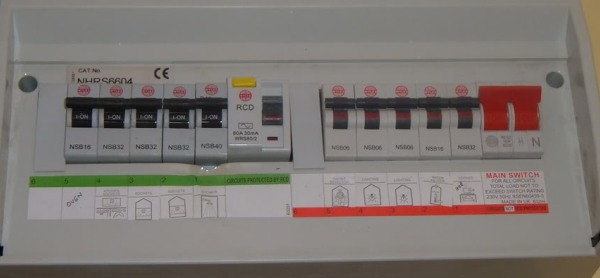At Warrington Electrical Services we offer services for domestic, commercial and industrial sectors. Get in touch to find out if we can help you.
Fuseboxes
The fuse box, also known as consumer unit should be easy to find. You should make sure you know where it is in case you ever need to turn the electricity off in an emergency. It usually contains three things, and they are used to control and distribute electricity around your home. They are the main switch; Fuses and/or circuit breakers; and Residual Current Devices.
This allows you to turn off the electricity supply to your home. You might have more than one mains switch, for example, if your home has electric storage heaters. In this case, you may have a separate fuse box.
B) Residual Current Devices (RCD)
These are switches that trip a circuit under dangerous conditions and instantly disconnect the electricity.
If your home has one or more RCD, test them regularly. Just follow the instruction label, which you should find near to the RCD. It should read as follows:
“This installation, or part of it, is protected by a device which automatically switches off the supply if an earth fault develops. Test every three months by pressing the button marked ‘T’ or ‘Test’.”
Testing the button every three months is important. The device should switch off the electricity. You should then switch it back on to restore the electricity. Do not hold the test button for a long period if the RCD does not trip. If it doesn’t switch off the electricity when you press the button, contact a registered electrician.
C) Circuit Breakers
These are automatic protection devices in the fuse box that switch off a circuit if they detect a fault. They are similar in size to fuses but give more precise protection. When they ‘trip’, you can simply reset the switch. But make sure you correct the fault first.
Fuses (not on the image, may be found in place of circuit breakers) – rewirable fuses have a piece of special fuse wire running between two screws. When a fault or overload current flows through the fuse wire, it will become hot and melt. The melted fuse breaks the circuit, disconnecting the faulty circuit and keeping you safe.
If your fusebox has a wooden back, cast iron switches, or a mixture of fuses it is likely that it dates back to before the 1960s and will need to be replaced.

